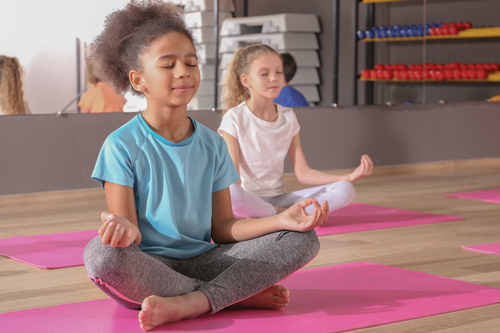
By: Amy Hartmann Garner, M.Ed, RYT-200
Like so many educators and vendors who are working to improve education in America, we here at PR with Panache! work at a fast pace—but we also know that speed alone won’t help us accomplish our goals. This post is the third in an ongoing series about how mindfulness can help all of us in education be happier, more productive, and ultimately more useful to the students we serve.

When I tell other educators that I’m a yoga instructor, they often say, “I’m not flexible,” or “I can’t move that way or touch my toes.” Many of them are under the impression they simply “can’t do yoga.” There is no “doing” yoga, there’s only practicing yoga. Yoga starts with subtle movements which lead to more complex movements and postures. This means you start small, by breathing and feeling sensations throughout your body. Then one day, you realize you’re able to move in ways that were difficult before. You’re able do things and see things in a way you never thought possible. Yoga is about being patient with yourself. Yoga is a natural teacher for everyone. Because yoga helps you learn about yourself, it’s also a natural fit for educators (and anyone who works with them). A practical way to start small with yoga is using it as a brain break.
Brain Breaks Build Focus
Incorporating stretching into your classroom is a great way to add movement, to help wake up the mind and body breaks, which can help to increase focus attention. It has always been difficult for me to sit still. I either have a leg bouncing up and down (most people ask me if I need to use the restroom) or I am moving constantly. I pace and sway when I have conversations with people. It was not until I started teaching and learning about sensory integration that I began to understand how movement is different for me. Movement is comforting to me, almost soothing. Although some classrooms offer a variety of flexible seating, most students are expected to sit in a chair—not designed for movement—for up to 90 minutes.
Chances are you have a student in your classroom who has trouble sitting still. When you incorporate brain and body breaks into your daily class routine, you’ll not only help this student to pay attention, you’ll assist the entire class (and yourself) in being able to focus better on the task at hand.
Brain breaks are research-based and are quick ways to get students to increase their ability to focus and get excess energy out. While reading my latest Yoga Journal, I came across an article by Tom Myers where he talks about the newest research which suggests that when you stretch, you are actually pulling on your cells’ DNA and changing how it expresses itself. This means that stretching regularly can alter the mechanical structure around your cells and change the way your genes function. Here are simple brain breaks that can work in the classroom or the boardroom.
Brain Break/Mindful Stretching Activities
When to Incorporate Brain Breaks
Breaks are part of my classroom routine, specifically during transitions. I often have the students stand up and do the morning stretch that I mentioned above. We stretch the right and left sides, go up on our tip toes, and touch the ground (or as low as the students can go). I have them take a few deep breaths to get the oxygen flowing. When they sit back down, they appear to be more energized and they’re sitting up straighter than before the stretching.
It can take the average brain up to 10 minutes to be “ready to learn” after a transition. Brain breaks stimulate and activate the brain while also increasing sustained focus. I give my students a brain break after our daily journal writing activity and sharing. Students put their journals away in the back of the classroom, which is a short movement break. Other possible times for brain breaks might be after your class warm-up, direct teach, or before students start independent assignments.
A sample class might look like this:
Whenever you incorporate it, stretching allows the body to form new patterns and release tension that has built up. In an age where technology is ever-present, slumping seems to be more and more of the norm. Doing yoga and mindful stretching allows you to create space in your chest. Having a regular practice allows the fibers in your muscles to thin out and glide more easily, causing pain to decrease, creating less resistance in movement, and allowing for more sliding in the joints.
So before you say, “I can’t do yoga,” give it a chance. What would you tell a student who is struggling academically? Would you say, “Quit trying, you’re right, you don’t know how to do this”? No, you would say, “Keep practicing,” or “Try it this way instead.” Think of yoga in terms of anything you have ever tried. The more you practice the better you get, and the easier it becomes.

Amy Hartmann Garner, M.Ed is a behavior support teacher and a registered yoga teacher at Eanes ISD in Austin, TX.
Follow her on Twitter: @amyhgarner | Email her: agarner@eanesisd.net
Thanks for sharing!
PRP Group, a Hawke Media Company, is an award-winning full-service education PR and marketing firm serving the pre-K–12 and higher-ed community.